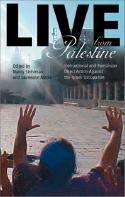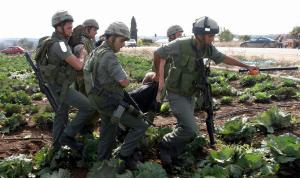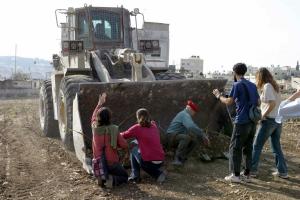Issue Date: February 6, 2004
Nonviolent resistance to the Israeli occupation demands international participation Reviewed by ANGIE O’GORMAN From the detention area of the military checkpoint between Nablus and the West Bank town of Beit Ferik, we watch the Israeli occupation of Palestine in operation. Four of us are here, members of the International Solidarity Movement assigned to facilitate the Palestinian olive harvest in Beit Ferik. The harvest has been blocked for the past three years because of violence by Israelis living in the surrounding settlements. Though difficult to watch, the game rules are not hard to master. One side creates an infrastructure of military checkpoints, disrupts all other paved routes with bulldozed trenches and heaps of rubble, then arbitrarily allows or refuses passage. A group of female college students are stopped because the soldier questioning them says they would kill him if they had a gun. There is no accusation that they have a gun. But there will be no university class for them today. They turn away frustrated, some crying. An ambulance is denied passage. Workers and teachers try to pass. Some are allowed through, others blocked, others simply made to wait and wait and wait. I feel rage growing in me and wonder how much of this I would put up with before opting to become a human bomb. Live from Palestine is about an alternative to rage in the form of nonviolent resistance. A compilation of short essays by Palestinian and international activists alike, it is the fruit of the International Solidarity Movement’s first two years of building a civilian-based nonviolent resistance movement to the Israeli occupation.
Applying nonviolence theory to the context of occupation, Palestinian Ghassan Andoni, a founder of the solidarity movement and a contributor to this collection, describes the organization as a Palestinian effort to dismantle the occupation’s most visible forms through noncooperation with checkpoints, settlement roads, the infamous wall, house demolitions and army incursions. The International Solidarity Movement has invited internationals to engage with them in this effort. I read Live from Palestine in preparation for a two-week stint as a solidarity movement volunteer and couldn’t have made a better choice. The essays are well-written, short and to the point. It is clearly the Palestinian perspective one is reading. For me, this was a much-needed counterbalance to the Israeli perspective in which I am immersed in the United States. I do not discount the Israeli perspective. It simply does not fully describe this conflict. Since American suppositions about Palestine flow from the Israeli point of view, an informed Palestinian viewpoint is invaluable. For that alone, this collection deserves to be read. In swift succession, the book takes us from the beginnings of the conflict, through Sharon’s September 2000 “walk about” the Temple Mount to the subsequent start of the second intifada, the 2001 founding of the International Solidarity Movement, and the experience of international activists present at times and places where Israeli forces successfully barred entrance to U.N. forces and the international press. The realities of nonviolent resistance on the ground, including the deaths of Rachael Corrie and other members of the International Solidarity Movement in 2003, are presented head on. There is no romanticism here. Nonviolence is not magic. It is a way of engaging in conflict and there are casualties. People get hurt and die. The effort continues.
A subplot emerges, somewhat unintentionally I think, for this book does not try to put the solidarity movement within a broader history of nonviolence. Yet a widened role for international activists in areas of violent conflict is evident. We see a turn toward greater engagement with “the facts on the ground,” in this instance, the dismantling of the mechanisms of violence against Palestinians. Previous efforts to place unarmed internationals at the side of the oppressed have emphasized accompaniment or witness to the conflict. The International Solidarity Movement wants hands-on involvement from internationals. This is a qualitatively new role for internationals. On the ground, in Beit Ferik a council member told us, “We have an idea [referring to nonviolent resistance]. If you will take risks with us, it will work.” This development deserves a volume in itself. Until then, readers will find ample material for thought and action in Live from Palestine. Published in 2003, it’s the most up-to-date commentary on the use of nonviolence against the occupation. Still I watch at the checkpoint as a Palestinian man brings several liters of Coke and Sprite to bribe a soldier, I assume, to gain passage. A very pregnant woman awkwardly climbs out of a taxi stopped at the requisite 700 yards before the checkpoint; her friend assists her in negotiating the hills of rubble and yards of ruts. They are allowed to pass and continue 700 yards further to a waiting taxi. Everyone travels by taxi here. But no taxi will come closer than 700 yards to a checkpoint because soldiers arbitrarily confiscate Palestinian vehicles to gut and burn them. Our teammate is arrested; we are blocked passage. We alert the local solidarity movement emergency response system, which now takes over as we walk and taxi the two hours to Beit Ferik, keeping in touch with our jailed mate by cell phone as we go. I am exhausted when we arrive at Beit Ferik. The back ways are hilly and rough and doubly long. We cross settlement roads on the run to avoid being shot by army patrols. When we arrive, we are briefed on settler violence toward these Palestinian farmers during the olive harvests of the last three years: gun shots, rock throwing, injury, death. Tomorrow we, too, will go into the olive groves. This is the reality of the occupation. I think of the stories of stamina and courage in Live From Palestine, remember my training, and take a deep and mindful breath. I am in good company. Angie O’Gorman lives and works in St. Louis, Mo., where she provides legal assistance to immigrants and refugees. National Catholic Reporter, February 6, 2004 |


